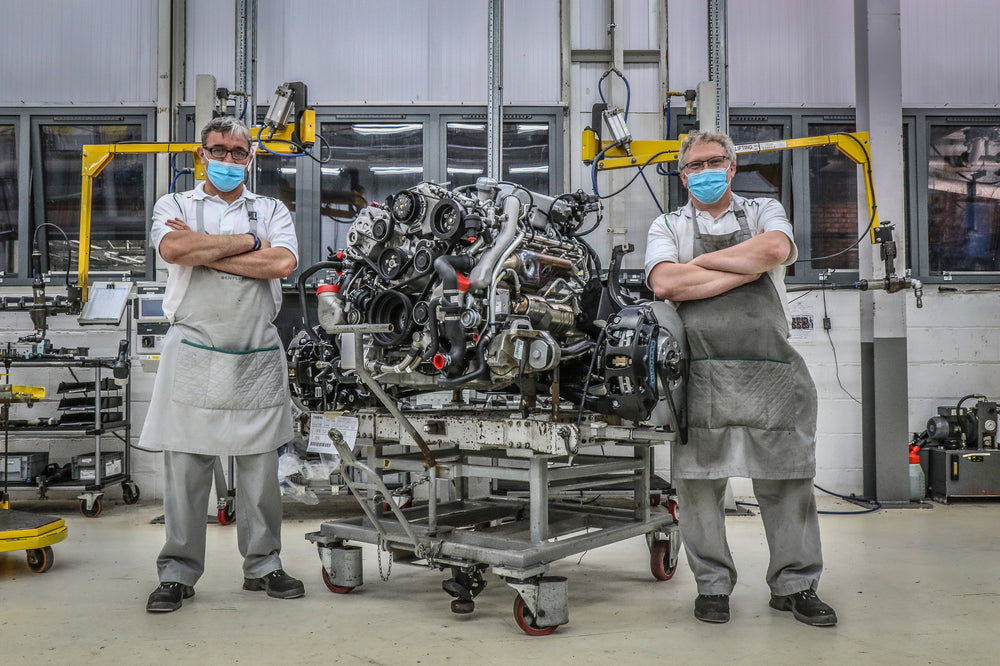The V8, which has powered the likes of the Corniche, the Silver Spirit, the Turbo R, the Arnage, and, most recently, the Mulsanne during the course of its lifetime, was first introduced in 1959 and has been in continuous production ever since. The final example, registered CZM003664, was hand-constructed by a team of seven engineers, a task that, in the case of the preceding 36,000+ V8s built, took 15 hours to hand-assemble. And yes, social distancing was in affect.






Dating back more than 60 years, and with then-senior engine designer Jack Phillips at the helm, development of the ‘L-Series’ V8 began in 1952 as a replacement for the six-cylinder powering the Mark VI (1946 to 1952, 4.3 to 4.6 litres) and the R-Type (1952 to 1955, 4.6-litre), among others. A solid engine, yes – a 4.9-litre version also powered the S1 from 1955 to 1959 – but one that lacked development scope having been in service with Bentley ownerRolls-Royce since the early 1920s.
Phillips’ confidential product soon bore fruit, the ‘L-Series’ boasting as it did an innovative aluminium block and classic V configuration for higher performance and smoother operation. That it also punched out 50 per cent more power than the six-cylinder it replaced did no harm either. More than 500 hours were spent bedding in Bentley’s new L-Series at full throttle, with “hundreds of thousands of miles in real-world conditions” being dedicated to sharpen the V8’s reliability.







Suitably impressed, the L-Series, a 6.2-litre example at this point, was put to its first production service in Bentley’s coach-built S2 just 18 months after pen hit paper. Though one rarely talks about anything as ghastly as power output in Bentley, 180bhp was certainly not something to scoff at. Of course, times change. The example being fitted to the Mulsanne Speed chucks out almost three times that at 530bhp and is accompanied by a mighty 1,100Nm (811lb ft) of torque, a hallmark of the new crankshaft, new pistons, new connecting rods and new cylinder heads first introduced to the Mulsanne for 2010.
By 1965, the L-Series was being prepped for Bentley’s new T-Series, essentially a re-badged version of the Rolls-Royce Silver Shadow and a model that would later take on the Corniche (1971) and Continental (1984) nomenclature. A tighter engine bay meant focus was now directed towards both improved performance (sorry, “conduct”) and more compact dimensions. Engineers even managed to squeeze an extra few brake horsepower from the 6.23-litre’s tank. The biggest change though came in 1971, when the 6.2-litre configuration was scaled up to, what would become, the engine’s definitive 6¾-litre iteration. Admittedly, power was much of a muchness, priority being given to increased stroke, and thus, more torque.




Few developments have been more seismic for the L-Series though than its time powering the Mulsanne, following the latter’s arrival in 1980. Ever stricter emissions control were one concern, as were heightened regulations regarding passenger safety: the V8 was once again put on a crash diet, this time to allow room for a collapsible water pump. Though shortening the V8 by four inches, this did at least mean the new Mulsanne met front end impact regulations. Two years later, silks were pulled from the new Mulsanne Turbo at Geneva, and the L-Series would become the firstBentley production V8 in more than 60 years to feature a turbocharger (twin-turbo would follow down the line). Power was hiked by almost 50 per cent – again! – to just shy of 300bhp, and 0-100kph in less than eight seconds meant the Turbo left its naturally-aspirated brethren for dust.
Though not for long. The short-lived Bentley Brooklands, first introduced in honour of the UK’s now demolished bank circuit by the same name in 1992, featured the most powerful production V8 in Bentley’s history when the badge was revived for 2008, punching as it did 530bhp and 1,050Nm (774lb ft) of torque. Somehow, a luxury limousine that weighed a little under three tons would smoke 0-100kph in just 5.3 seconds. Boasting 200 per cent more power and torque than the Arnage it replaced, this was leaps and bounds beyond the realms of “adequate”.
The above V8 will power the final completed example of Bentley’s new Mulsanne 6.75 Edition by Mulliner, a farewell tribute to the brand’s flagship limousine which this year ends production after a decade of service. Bentley’s new flagship, the Flying Spur, will feature a hybrid powertrain from 2023 onwards, with a hybrid V6 already in the works.
*Images courtesy of Bentley




















































